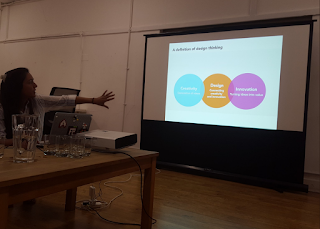How design thinking saved my beauty startup
Hey guys!
Last week, I went to Launch22's Design Thinking session on their Incubator programme. This session came at a really good time for me and my beauty startup. At the moment, me and my cofounder are trying to figure out the business problem/question: is there even a demand for Asian beauty products in the UK? I learnt that the design thinking process can be used to solve this problem.
The session was run by Ayesha Dosaj who is a fashion retail professional for lots of big fashion brands so she's used the design thinking process in her work plenty of times!
So what is design thinking? Well it's a creative method to solve difficult problems and there's 5 parts to it.
First, you seek to understand your users by empathising with them through interviews, surveys, research, observation. For me, I'll create a beauty survey and ask women for their opinions on buying Asian beauty products. Have they used it before? What do they like about it? What do they hate?
Then I need to gather all the research and define the problem that my users have. Are women in the UK looking for Asian beauty products in the high street shops but can't find it? Or maybe my research shows that women have so many unused beauty products and they end up with expired products? If they are having these problems, then I would have defined the problem of my users. Defining the problem is key to finding a solution for it.
Next, I need to generate a whole bunch of ideas to solve their problem of not being able to access Asian beauty products. Could I set up my own pop up store selling Asian beauty products? Could I sell it online?
The next stage involves prototyping. This is the part where I actually build my idea and turn it into real life. So in my case, I could create an online store or a physical pop-up store and sell Asian beauty products.
Next, I need to test, test, and test the prototype! This is where I ask for feedback from my customers. Do they like the beauty products I am selling them? If they don't, then I need to go and buy the products they actually like.
This is not the end though. I need to keep empathising with my customers, defining their problems, coming up with more ideas, prototyping those ideas and testing it some more. And I keep doing this over and over again. Hopefully, by going through these loops, I'm reducing my customer's 'pains' and providing them more value with my business.
So, that's an overview of the design thinking process and how it applies to my beauty startup. If you're interested in design thinking, it's definitely worth studying the methodology in more detail because it can really help you solve difficult problems in your startup.
Last week, I went to Launch22's Design Thinking session on their Incubator programme. This session came at a really good time for me and my beauty startup. At the moment, me and my cofounder are trying to figure out the business problem/question: is there even a demand for Asian beauty products in the UK? I learnt that the design thinking process can be used to solve this problem.
The session was run by Ayesha Dosaj who is a fashion retail professional for lots of big fashion brands so she's used the design thinking process in her work plenty of times!
So what is design thinking? Well it's a creative method to solve difficult problems and there's 5 parts to it.
First, you seek to understand your users by empathising with them through interviews, surveys, research, observation. For me, I'll create a beauty survey and ask women for their opinions on buying Asian beauty products. Have they used it before? What do they like about it? What do they hate?
Then I need to gather all the research and define the problem that my users have. Are women in the UK looking for Asian beauty products in the high street shops but can't find it? Or maybe my research shows that women have so many unused beauty products and they end up with expired products? If they are having these problems, then I would have defined the problem of my users. Defining the problem is key to finding a solution for it.
Next, I need to generate a whole bunch of ideas to solve their problem of not being able to access Asian beauty products. Could I set up my own pop up store selling Asian beauty products? Could I sell it online?
The next stage involves prototyping. This is the part where I actually build my idea and turn it into real life. So in my case, I could create an online store or a physical pop-up store and sell Asian beauty products.
Next, I need to test, test, and test the prototype! This is where I ask for feedback from my customers. Do they like the beauty products I am selling them? If they don't, then I need to go and buy the products they actually like.
This is not the end though. I need to keep empathising with my customers, defining their problems, coming up with more ideas, prototyping those ideas and testing it some more. And I keep doing this over and over again. Hopefully, by going through these loops, I'm reducing my customer's 'pains' and providing them more value with my business.
So, that's an overview of the design thinking process and how it applies to my beauty startup. If you're interested in design thinking, it's definitely worth studying the methodology in more detail because it can really help you solve difficult problems in your startup.



Comments
Post a Comment